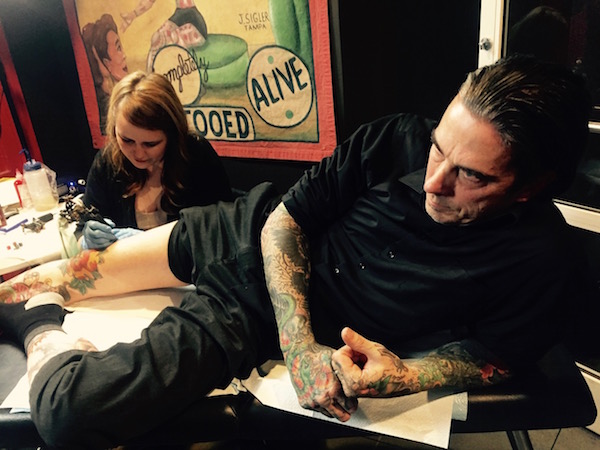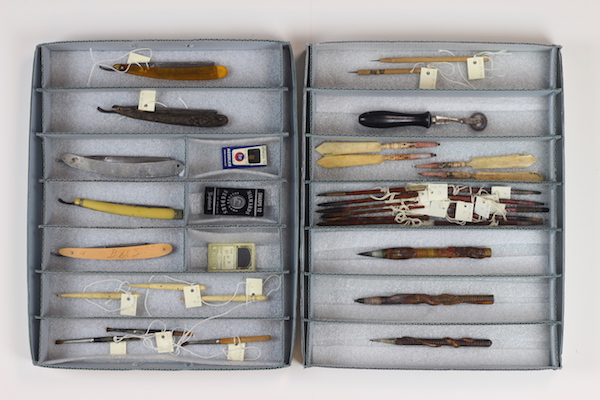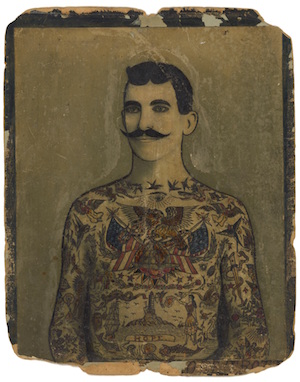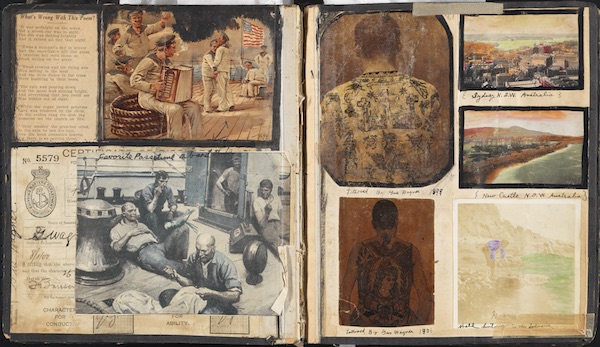
BY PUMA PERL | From the act itself to the passing down of techniques and tools, tattooing is an intimate endeavor — so it is fitting that the South Street Seaport Museum’s new exhibition should bear such distinct marks of artistry, legacy, and collaboration.
“The Original Gus Wagner: The Maritime Roots of the Modern Tattoo” is a fascinating look at tattoo history through the study of a unique, exuberant artist: Augustus “Gus” Wagner (1872-1941).
During his time as a young merchant seaman, Wagner claimed to have been trained in the use of hand-made tools by tribesmen in Java and Borneo, and later studied under practitioners in Australia and London. By 1908, he was billing himself as “the most artistically marked up man in America,” with over 800 tattoos. Throughout his career, he continued to use his hand-held instruments, despite the emergence of electric tattooing machines. His work as a traveling tattooist, tattooed man, and circus performer spanned over 40 years. Along with other wandering artists, Wagner brought the art of the tattoo inland from coastal ports, making it part of small town American culture. Included in the exhibition are videos, tattooing tools, flashes, and pages from Wagner’s scrapbook, providing an education in hand tattoo techniques and a closer look into Wagner’s life.
Wagner met his wife, Maud, an aerialist and contortionist, at the 1904 Louisiana World’s Fair. He offered her a tattooing lesson in return for a date. Under his tutelage, she became the first well-known female tattooist. Their daughter, Lovetta, began tattooing at the age of nine; unlike her mother, whose body was covered by Wagner’s work, she had no tattoos of her own.

The Alan Govenar and Kaleta Doolin Tattoo Collection at the South Street Seaport Museum has a winding road that began when Alan Govenar was a 21-year-old studying American Folklore at Ohio State University. Seeking a subject for a fieldwork assignment, he came across a sign reading “As Ancient as Time, As Modern as Tomorrow — Tattooing by the Teacher of the Art Since 1928.” The tattooist turned out to be Old School artist and circus performer Leonard L. “Stoney” St. Clair (1912-1980). Govenar became a frequent visitor to the shop, and his lifelong fascination with tattooing began. Today, Govenar’s body of work on the topic includes the book “Stoney Knows How: Life As a Sideshow Tattoo Artist” and its award-winning documentary film adaptation, and three books with the legendary Don Ed Hardy, whose tattoo designs became the basis for a popular fashion line.
“It was very important to me to bring this [exhibition] to the Seaport Museum,” said writer, filmmaker, photographer and folklorist Govenar. “Not only for the sake of tattoo history, but to support the Museum.”
Seaport Museum Executive Director Captain Jonathan Boulware added, “Remarkably, four years after Hurricane Sandy, we’re still recovering. It’s also worth noting that we hadn’t yet fully recovered from the prior two blows: 9/11 and the recession of 2008. So, all things considered, we’re doing quite well! There’s much to be done to bring us fully back on line as the cultural anchor to the South Street Seaport Historic District, the birthplace of New York City. Exhibitions like this one are just right for us as we move ahead.”
The Jan. 28 opening reception included a live demonstration, utilizing Wagner’s original tattoo designs, by Daredevil Tattoo artists Brad Fink and Michelle Myles (141 Division St. in Chinatown; daredeviltattoo.com). Michael Wyatt had flown in from Dallas to attend the opening and to be tattooed by Myles, choosing a dragon head as his image. Wyatt became acquainted with Govenar at his coffee-roasting studio, Full City Rooster. Last July, he presented a studio event, “American Tattoo: As Ancient as Time, As Modern as Tomorrow,” with Govenar as special guest speaker (the event title is the same as Govenar’s 1996 ArtBox, which contained a 48-page book, 15 postcards, and three temporary tattoos).

Unlike the heavily inked Wyatt, Colin Graham, a Mariner at the Seaport Museum, was a tattoo virgin.
“I don’t think most people get their first tattoo at a museum’s opening exhibition,” he said. “I was a little anxious doing it in open view of a bunch of people, but I couldn’t turn down the opportunity to get tattooed by a first-class artist, and to choose an image from Gus Wagner’s collection. Brad joked with me while I was getting the piece done that I was going to probably feel a little lopsided and want to get one on my other arm. I do see some truth to the thought that once you have one, you’ll want another; the mental hurdle of getting your first is much bigger than for your second… I couldn’t be happier with how it came out. Brad Fink did a fantastic job, and I couldn’t imagine a better first tattoo.”
On view through June 4 at the South Street Seaport Museum (12 Fulton St., btw. South & Water Sts.). Museum hours: Wed.–Sun., 11am–5pm. The exhibit is free with Museum admission: $12 for adults; $8 for seniors (65+), $6 for ages 6–17. Tickets can be purchased in person at 12 Fulton St. or online at southstreetseaportmuseum.org. For info about Govenar’s work, visit docarts.com/about_us.html.


















